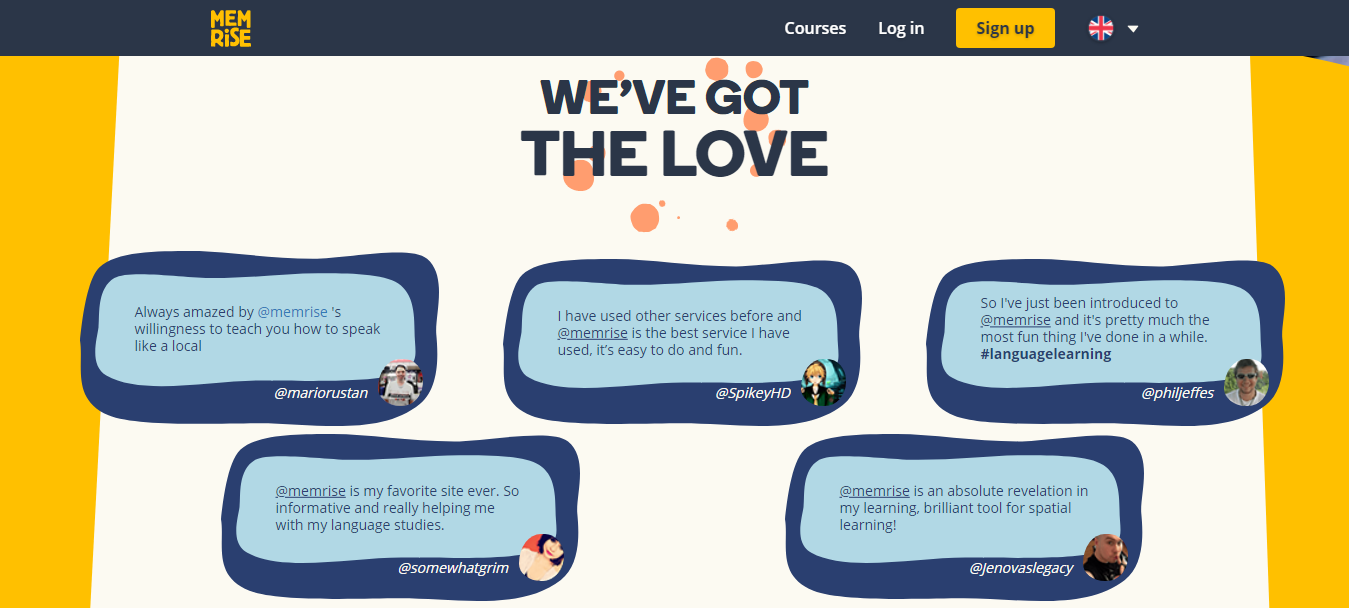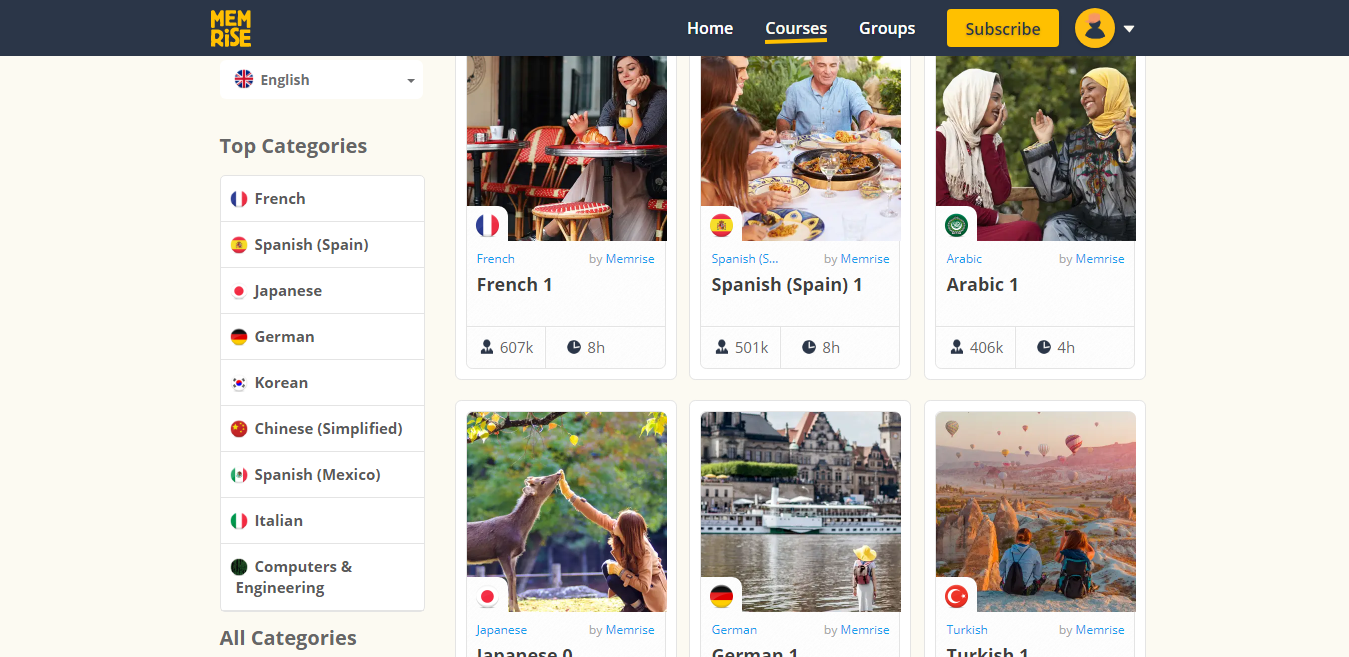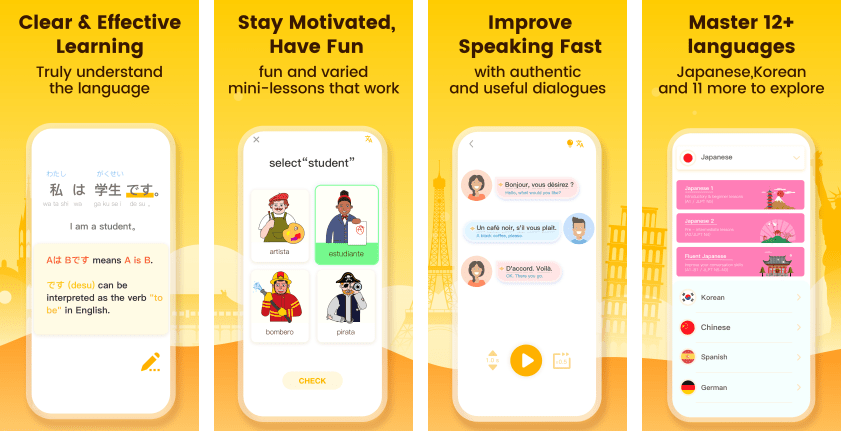Both Memrise and LingoDeer are tough competitors. Both have some excellent features whose levels cannot be matched. Both of them have competitive pricing plans as well. All these reasons make it hard for us to decide whether to choose Memrise and LingoDeer.
Here in this article, I have compared both Memrise and LingoDeer in detail that will help you make an informed decision as to which one you should choose. So, let us begin.

MemriseLearn More |

LingoDeerLearn More |
|---|---|
| $ Pricing | USD 7.50 | USD 14.99 |
| Best for |
Memrise is a flash-card app at its core. This is a sheet of paper with a word or phrase printed in your target language on one side and the translatio |
LingoDeer is committed to teaching you a language holistically, implying that fluency is more than the sum of its components. Its grammar-based framew |
| Features |
|
|
| Pros | |
|
|
| Cons | |
|
|
What Is Memrise?
Memrise is a flash-card app at its core. This is a sheet of paper with a word or phrase printed in your target language on one side and the translation on the other. It is mostly devoted to online language learning. Nonetheless, you may use the program to remember and practice vocabulary from a variety of different areas and professions.
To summarize, this is a vocabulary-learning tool that Memrise enhances with cutting-edge technology. Memrise helps you remember unknown words and phrases by using mnemonics and spaced repetition, which they demonstrate by growing flowers.
You will encounter seeds of unlearned vocabulary. After that, you plant them (i.e., educate yourself) and eventually transform them into a flower.
Assume you want to improve your vocabulary and extend it further in a language of your choosing. In such instances, ten-minute engaging activities might be used to drill new phrases. It assists you in acquiring a fundamental understanding of a foreign language.
What is LingoDeer?
LingoDeer is committed to teaching you a language holistically, implying that fluency is more than the sum of its components.
Its grammar-based framework is intended to fill in those critical gaps, while the conventional classes aid in the development of your vocabulary, grammar, pronunciation, and sentence structure. Additionally, each session covers a variety of topics, giving you a more complete picture of the language as a whole.
LingoDeer’s curriculum is divided into four distinct components: the lesson itself, in which you are given vocabulary and instructed to construct sentences; learning tips, in which the grammar points for each unit are thoroughly explained; story mode, in which you are given a video clip and complete reading and listening exercises; and vocabulary, in which you can practice the words you’ve learned.
Major Features and Benefits of Memrise
1. Mems:
Memrise makes use of mnemonics to assist you in memorizing the language more effectively. It makes use of what it refers to as “Mems,” which are simply customized flashcards.
Each mem was produced by a user, and you may make your own if you don’t find one you like (or one at all). I was a bit upset that I couldn’t find any vocabulary for the Memrise Italian 1 course that already had mems.
I had to design my feature to utilize it for this course. This was also true for the other Memrise Level 1 courses I looked out for.
The method is rather straightforward, and Memrise includes guidance on how to design an effective mem. Association, imagination, and visualization are the three stages.
By linking the word or phrase with how it sounds in English or with whatever it makes you think of, and creating a visual to symbolize that concept, you may significantly improve your recall. Here’s a mem I designed for the Italian word for “good luck.”
While the program makes it simple to add photos and text, you’ll need to upload your own or discover one online and then download it to your computer. The most challenging aspect of developing mems is the imagination/visualization stage. It might be challenging to generate meaningful connections, and it demands patience. As a result, I did not make considerable use of the function.
The software seems to be best suited for fast study and memorizing. Creating mems slowed the procedure down significantly for me, and hence I avoided it.
2. Learn New Words:
This sort of lesson begins with a video of a native speaker uttering a word. It is your responsibility to listen and locate the Italian match.
I found the utilization of videos to be both fascinating and beneficial; it’s far easier to listen to someone while viewing them than it is to listen to an audio clip without pictures. Following that, you’re presented with the English translation.
This is where you may construct a mem or categorize it as a “difficult term.” This is done for each of the new terms in the lesson. Memrise also incorporates review exercises, such as the ones listed below, to assist you in reviewing what you’ve just learned.
3. Courses:
The majority of courses follow a logical and intuitive flow. They begin with simple words and phrases and gradually progress to more complex ones. Additionally, some courses provide brief grammar instruction.
You are supplied with vocab and a translation at the start of each new lesson. This is accomplished by the use of brief films of native speakers uttering the word or phrase.
I like that the program gives exact translations of sentences, even when they do not make complete sense. I could understand some individuals having an issue with this, preferring a system that minimizes thinking in English.
When you first come across a term, you’ll be faced with recognizing its written form, English definition, and audio.
Memrise advises the sort of lesson you should perform according to your skill level, whether it’s new content practice or review. You may do anything you like, but in most cases, it makes the most sense to follow the advised course of action.
4. Content:
The program’s structure is rather straightforward in theory: you begin by looking for a course that interests you. However, the site itself might seem a little disorganized. Due to the abundance of user-generated material, the possibilities seem limitless.
This is just a sampling of the results from my search for “Advanced Spanish.” Memrise-created courses are featured first, followed by user-generated material in order of relevancy and popularity. You may see the duration of each course as well as the number of students enrolled.
Courses published by Memrise users vary significantly in terms of quality. While looking for advanced Spanish classes, I came across some that were compilations of vocabulary based on their frequency of usage and others that were loose groupings of Spanish idioms.
Certain types of user-generated information are quite particular and may be extremely useful: slang terms, business jargon, and specific grammatical issues, for example.
When searching for Albanian language material, I discovered that the majority of user-created courses lacked an audio component. This rendered the classes completely ineffective for me; memorizing a lot of difficult-to-pronounce vocabulary is both time-consuming and ineffective.
The official Memrise courses are often substantially more expensive. Memrise offers seven courses covering the most common languages, and the instructions are provided in a range of languages, making it accessible to non-native English speakers as well.
At the moment, Memrise offers official courses in 21 languages. Mongolian, for example, has just two approved Memrise levels.
Major Features and Benefits of Lingodeer
1. Travel Phrasebook:
Except for Vietnamese, all languages supplied by LingoDeer include a trip phrasebook. This function is specific to the smartphone app, but it includes a large selection of useful words for self-introductions and pleasantries, as well as travel, eating, and shopping. Best of all, this function is available to everyone; no membership is required!
2. Character Drills:
On the mobile edition of LingoDeer, Chinese and Japanese classes include character drill activities that will assist you in learning not only how to read the characters but also how to write them correctly.
3. Vocabulary:
The vocabulary section of Lingodeer, similar to the Lesson section, enables you to browse a complete list of the terms you learn in any particular unit and return to review them if you’re having difficulties remembering them.
4. Story Mode:
This part will begin with a brief movie and will continue with two sorts of exercises: reading and speaking. LingoDeer provides you with questions in your target language throughout the reading section. While you may not be able to read the question in its entirety, you will be able to deduce the answer based on the lesson from the context.
The speaking section requires you to record yourself speaking in response to the audio samples. You will be able to compare your audio to the sample audio to enhance your pronunciation.
5. Learning Tips:
Learning Tips is the closest thing LingoDeer has to a textbook. Each course is accompanied by a Learning Tips website that thoroughly explains the grammatical issues, including charts and examples for your reference. The explanations are succinct and the examples are well-defined, maximizing the book’s effectiveness as a learning tool.
6. Lessons:
If you’re acquainted with the Rosetta Stone technique, you’ll recognize the lessons in LingoDeer. You’re often shown with images and asked to choose the one that most closely resembles the word you’re practicing.
For languages that do not utilize the Latin alphabet, romanizations are provided alongside the language’s script to aid with pronunciation. This is temporary until you have a firmer grasp of the writing method.
While these romanizations may sometimes be confusing (Korean is a particular culprit), the accompanying audio more than compensates with its sharpness and clarity.
Additional activities include multiple-choice, complete-the-sentence, matching, and—a rare occurrence—typing the sentences out yourself. In the event of non-Latin scripted languages, you’ll need to install the proper keyboard and be knowledgeable enough with the alphabet to be able to enter it.
Fortunately, LingoDeer provides a remedy for this if it becomes a problem for beginners: just click the “Help me!” button to convert the exercise to a point-and-click complete-the-sentence exercise.
Features Verdict
As you can see, the features of both these platforms are great, but after the detailed analysis of both of their features, we can clearly say that LingoDeer is better than Memrise.
Memrise Vs. LingoDeer Pricing
Memrise –
They have 3 pricing plans to offer –
- Monthly Plan: This will cost you $ 8.99 per month.
- Annual Plan: This will cost you $ 7.50 per month.
- Lifetime: This will cost you $ 139.99 for a lifetime.
LingoDeer –
They have 4 pricing plans to offer –
- 1-Month Plan: This will cost you $ 14.99 per month.
- 1-Quarter Plan: This will cost you $ 39.99 per quarter.
- 1-Year Plan: This will cost you $ 79.99 per year.
- One-Time-Purchase: This will cost you $ 159.99 for a lifetime.
Verdict
As you can see the pricing plans of LingoDeer are higher than that of Memrise. So, in pricing, the clear winner is Memrise.
Quick Links
FAQs | Memrise Vs LingoDeer
✅Is Memrise worth the subscription price?
Memrise is an excellent tool for language study, especially for beginners who are still learning new characters and fundamental vocabulary. The fact that it is more than flashcard software adds to its appeal. And the free tier of service is more than enough. You never get the sense that you’re approaching a paywall.
❓Can Memrise help you become fluent?
While Memrise cannot guarantee that users will become proficient in a new language, the majority of courses may bring users to an upper-intermediate/advanced level. The courses will grow in complexity, so that novices may begin with no prior knowledge of the language and ultimately achieve intermediate or advanced skills.
⁉️Is Memrise a grammar tutor?
Yes. Grammar levels are accessible through the course dashboard. To begin, just hit the appropriate levels and choose “Learn Grammar.” Following that, you will be required to take multiple-choice, tapping, and typing examinations about the grammatical point.
🤩Can LingoDeer help you become fluent?
While Lingodeer is an excellent method to begin started learning a language, it will not carry you to proficiency. At some point, you’ll need to expand your search.
😮Is LingoDeer’s price tag justified?
In general, I believe that LingoDeer is an excellent application that is well worth the membership fee, particularly if you get a LingoDeer Lifetime Membership. Having said that, I would suggest this software to beginners.
🤷♀️Where is LingoDeer headquartered?
LingoDeer, located in Hong Kong, China, provides a customizable app for language learning that is structured on grammar.
Final Verdict | Memrise Vs LingoDeer 2024
As you can see in the above comparison, both these platforms have done incredibly well. The pricing plans of Memrise are lower than those of LingoDeer however, the features of Lingodeer are better than those of Memrise.
We would recommend going for LingoDeer, as its features are better than Memrise, and the price is also not very high when compared with Memrise.










